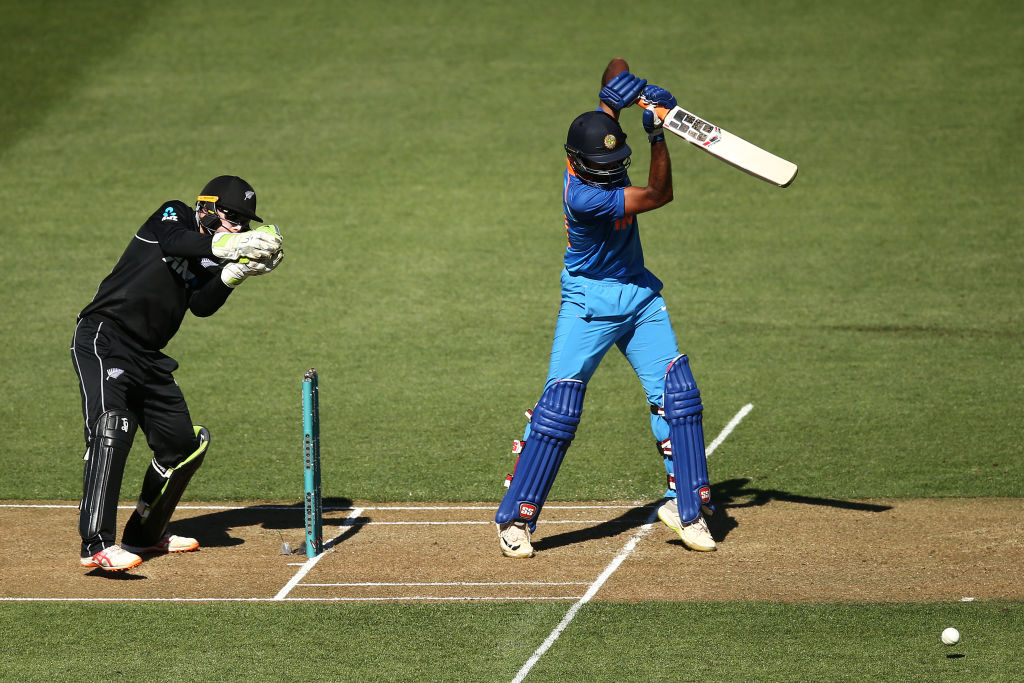India vs New Zealand | Takeaways: Vijay Shankar’s redemption and Hardik Pandya’s six-hitting ability
India finally got it right as the middle-order clicked to get India past 250 after being reduced to 18/4, and the bowling brilliance helped the team to a 35-run win. While Ambati Rayudu was impressive with the bat, Vijay Shankar’s slow road to batting redemption was the highlight of the day.

Vijay Shankar’s slow road to redemption
In the domestic circle, Vijay Shankar is highly regarded as a grafter and a solid middle-order batsman. His ability to grind out at the time of need and open the arms to score with a high strike rate at other times made him Tamil Nadu’s most-trusted batsman despite the presence of Murali Vijay and Baba Indrajith. However, the Nidahas Trophy final, which was the only innings where he got a chance to bat for India until today, made a public perception that he is a bits-and-pieces cricketer, doing holding job in the middle overs with the ball and mediocre with that. Shankar needed a moment of his own to prove that he is more than that and Wellington gave him a chance to do just that.
When Shankar came out to bat, India
India got what they wanted
India, in no uncertain terms, had made it clear that they were looking at the series as an opportunity to give sufficient match time to the players ahead of the World Cup and were unfazed about the result of the series. Keeping that in mind, Rohit Sharma decided to bat first despite knowing that the moisture would work against their batsmen. It was a brave decision, but as expected, New Zealand bowlers found their groove almost instantly to reduce India to 18/4. Then, India promoted Vijay Shankar to partner Ambati Rayudu, and the duo played their part to perfection.
While Shankar was more fluent of the duo, Rayudu took his time to settle - he scored 5 runs off 33 balls at one point - but he knew that he could easily manage to up the strike rate once he was set. After hitting Colin de Grandhomme for a six, he was well at home and easily managed to strike clean even after Shankar’s dismissal. Hardik Pandya’s 45-run innings also gave India a very good finish and that made it easier to forget that Kedar Jadhav had an off-day with the ball. This was exactly what India needed from their middle-order, to take over the position when the top-order failed to deliver, and it will hold them in a good position for the World Cup if they keep that going.
Hardik Pandya against spinners - a better love story than Twilight
Bowling full or short wasn't the only plan the Kiwis quicks had as they were also disciplined enough to consistently bowl outside off as well to induce that odd edge. Until the 35th over of the innings, India failed to score more boundary behind square on the leg side. There were no fine tickles or guiding shots because you can play these shots only to balls veering in towards leg stump and Kiwi pacers didn’t give enough chances. Spinners also stood out in that aspect. However, Hardik Pandya got into the groove very soon. After seeing out the only ball of Todd Astle, he hit him for three consecutive sixes which brought back the memories of his assault against Adam Zampa in Indore in 2017.
Unlike Zampa, there was nothing wrong with what Astle did when Hardik Pandya creamed him for three consecutive sixes. The leggie bowled flatter and fuller in the hope of making it difficult for Pandya to get under the ball and in the process, he gave requisite elevation in the air too. But he was unaware of Pandya’s special ability until then. The good thing for Pandya is that he doesn't need to use his feet to generate the momentum and that helps him go aerial down the ground easily. Had Astle knew Pandya wouldn't stop after the first six, he might have gone slower and wider on the following deliveries, but the Baroda player’s lack of feet movement kept the bowler guessing and eventually made him one of the five unfortunate bowlers who

Comments
Sign up or log in to your account to leave comments and reactions
0 Comments